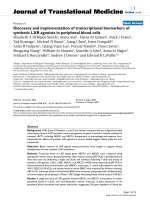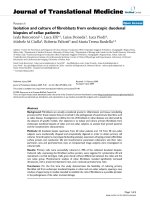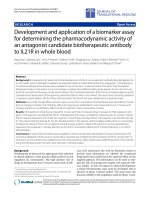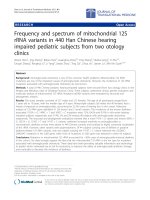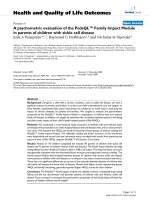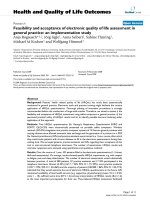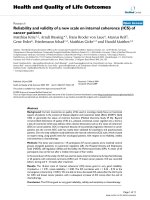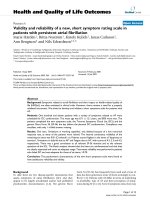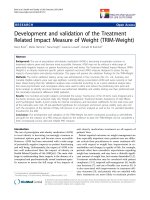Báo cáo hóa học: "Preparation and evaluation of novel mixed micelles as nanocarriers for intravenous delivery of propofol" potx
Bạn đang xem bản rút gọn của tài liệu. Xem và tải ngay bản đầy đủ của tài liệu tại đây (594.32 KB, 9 trang )
NANO EXPRESS Open Access
Preparation and evaluation of novel mixed micelles
as nanocarriers for intravenous delivery of propofol
Xinru Li, Yanhui Zhang, Yating Fan, Yanxia Zhou, Xiaoning Wang, Chao Fan, Yan Liu
*
and Qiang Zhang
*
Abstract
Novel mixed polymeric micelles formed from biocompatible polymers, poly(ethylene glycol)-poly(lactide) (mPEG-
PLA) and polyoxyethylene-660-12-hydroxy stearate (Solutol HS15), were fabricated and used as a nanocarrier for
solubilizing poorly soluble anesthetic drug propofol. The solubilization of propofol by the mixed micelles was more
efficient than those made of mPEG-PLA alone. Micelles with the optimized composition of mPEG-PLA/Solutol HS15/
propofol = 10/1/5 by weight had particle size of about 101 nm with narrow distribution (polydispersity index of
about 0.12). Stability analysis of the mixed micelles in bovine serum albumin (BSA) solution indicated that the diblock
copolymer mPEG efficiently protected the BSA adsorption on the mixed micelles because the hydrophobic groups of
the copolymer were efficiently screened by mPEG, and propofol-loaded mixed micelles were stable upon storage for
at least 6 months. The content of free propofol in the aqueous phase for mixed micelles was lower by 74% than that
for the commercial lipid emulsion. No significant differences in times to unconsciousness and recovery of righting
reflex were observed between mixed micelles and commercial lipid formulation. The pharmacological effect may
serve as pharmaceutical nanocarriers with improved solubilization capacity for poorly soluble drugs.
Introduction
Propofol, chemically named 2,6-diisopropylphenol, is a
highly effective and rapid intravenous anesthetics, which
has g ained increasing popularity in anesthesia in c linic.
Its greatest advantage is the rapid recovery, even after
long periods o f anesthesia. A p articularly low incidence
of postoperativ e nausea and vomiting was also observed
[1,2]. However, it also has some drawbacks such as poor
water miscibility (150 μg/L) [3] and high lipophilicity
(logP = 4.16) [4]. As vehicle s for clinical delivery of
anesthetics should be devoid of sedative and anesthetic
properties, as well as toxic side effects, nearly all small-
molecular weight organic solvents into which propofol
is freely miscible are not useful. Therefore, propofol was
initially formulated as a 1% solution in 16% Cremophor
EL, which has been reported to induce undesirable side
effects, such as the high occurrence of pain on injec tion
and the risk of an aphylactic reactions associated to Cre-
mophor EL. In view of the clinical importance of propo-
fol, the alternative formulations such as oil/water
emulsion consisting of soya be an oil, glycerol , and egg
phosphatide (Diprivan
®
,Zeneca,UK)[5],microemul-
sions [6], inclusion complex [1], and polymeric micelles
[7,8], have been developed to improve its solubility.
Unfortunately, lipid-based emulsions suffer from other
limitations including poor physical stability and the
potential for embolism. S trictly aseptic techniques must
be maintained when handling these formulations since
they do not contain antimicrobial preserv atives, and the
vehicle can support rapid growth of microorganisms
[9,10]. Among other particulate ve hicles, polymeric
micelles have presented their great potential in solubili-
zation of poorly water-soluble drugs in recent years
[11-14]. Generally, block copolym ers with concentration
above the critical micellization concentration (CMC)
self-assemble into spherical polymeric micelles with a
core-shell structure in water: the hydrophobic segments
aggregate to form an inner core being able to accommo-
date hydrophobic drugs with improved solubility by
hydrophobic interaction s; th e hydr ophilic shell c onsists
ofabrush-likeprotectivecoronathatstabilizesthe
micelles in aqueous solution [15-17]. Polymeric micelles
as novel drug vehicles present numerous advantages,
such as reduced side effects of drugs, selective targeting,
stable storage, and stab ility toward dilution [17,18].
Furthermore, polymeric micelles p ossess a nanoscaled
* Correspondence: ;
Department of Pharmaceutics, School of Pharmaceutical Sciences, Peking
University, Xueyuan Road 38, Haidian District, Beijing 100191, People’s
Republic of China
Li et al. Nanoscale Research Letters 2011, 6:275
/>© 2011 Li et al; licensee Springer. This is an Open Access article distributed under the terms of the Creative Commons Attribution
License (http://creativecommon s.org/licenses/by/2.0), which perm its unrestricted use, distribution, and reproduction in any medium,
provided the original work is properly cited.
size with a narrow distribution. They can protect drugs
against oxidation in vitro and premature degradation in
vivo owing to their core-shell architecture [19,20]. More
importantly, polymeric micelles are fabricated according
to the physicochemic al properties of drugs and the c om-
patibilitybetweenthecoreofmicellesanddrugmole-
cules [14,21]. Unfavorably, propofol-loaded polymeric
micelles formed fr om poly(N -vinyl-2-pyrrolidone)-block-
poly(d,l-lactide) (PVP-PLA) copolymers [7,8], the drug
loading content (LC) was extremely low (7 to 12%).
Therefore, there has been an urgent quest to develop an
ideal polymeric micelles formulation that can solubilize
propofol efficiently and solve some of the aforementioned
problems.
This study presented a newly mixed micelle structure of
methoxy poly(ethylene glycol)-b-poly(d,l-l actide) (mPEG-
PLA) diblock copolymers and Solutol HS 15, which was
expected to manifest increased drug loading efficiency,
superior to those of the individual components, and at
least maintain the efficacy of propofol. Solutol HS 15, the
main component of which is the polyethylene glycol 660
ester of 12-hydroxy stearic acid, is a low molecular weight
surfactant and recommended as non-ionic solubili zing
agent to be added to injection solutions [22]. Its relatively
bulky li pophilic portion might allow it for better drug
solubilization. This micellar structure involved no t only
the modification of particles to hide the inner structure to
prevent recognition by the physiological system, but also a
new means of preparing micelles with higher drug LC
from a copolymer with a low molecular weight surfactant.
Therefore, the micelle preparation, propofol solubilization,
and in vitro micelle properties were investigated by the
size measurement, drug LC, encapsulation efficiency (EE),
physical stability, and in vitro drug release. The in vivo
pharmacological effe ct of propofol-loaded mixed micelles
was also evaluated.
Materials and methods
Materials
Propofol was purchased from Zhongke Taidou Chemical
Co., Ltd. (Shandong, China). mPEG5000-PLA4800 copo-
lymers were synthesized in our laboratory as previously
described [23]. Solutol HS15 was obtained from Yunhong
Chemical Co., Ltd (Shanghai, China). The commercial
lipid emulsion (CLE ) injection for propofol (1%, w/v) was
provided by Guorui Pharmaceutical Co., Ltd. (Sichuan,
China). All other reagents were of analytical grade, except
those for HPLC assay which were of HPLC grade.
Animals
Sprague-Dawley (SD) rats weighing 200 ± 20 g were
obtained from Animals Center of Peking University
Health Science Center. All animals were provided with
standard food and water ad libitum and were exposed to
alternating 12-h periods of light and darkness. Tempera-
ture and relative humidity were maintained at 25°C and
50%, respectively. All care and handling of animals were
performed with the approval of Institutional Authority
for Laboratory Animal Care of Peking University.
Determination of critical micellization concentration
The CMC was determined by fluorescence spectroscopy
using pyrene (Fluka, > 99%, St. Louis, USA) as a hydro-
phobic probe as previously reported [11]. The fluorescence
spectra of pyrene were measured at varying mixed micelle
concentrations using a Shimadzu RF-5301 PC fluores-
cence spectrometer (Kyoto, Japan) at 25°C. The excitation
wavelength was adjusted to 392 nm, and the detection of
fluorescence was performed at 333 and 335 nm. CMC was
measured from the onset of a rise in the intensity ratio of
peak at 335 nm to peak at 333 nm in the fluorescence
spectra of pyrene plotted versus the logarithm of polymer
concentration.
Preparation of mixed micelles
The drug-free mixed micelles were prepared by rotary eva-
poration method [23]. In brief, a met hanol solution of
mPEG-PLA and Solutol HS15 with differe nt molar ratios
was evaporated under vacuum at 60°C to form a homoge-
neous film. The resulting film was dispe rsed in 10 mL of
water at 60°C and then vortexed for 3 min. Then the mix-
ture was filtered through a 0.45-μm filter (Millex-GV,
Millipore, USA) to obtain a clear and homogeneous
micelle solution. The propofol-loaded mixed micelles were
prepared by mixing propofol and the prepared drug-free
micelle solution under magnetic agitation at room tem-
perature. Then the resultant mixture was incubated at 4°C
for 30 min and filtered. The filtrate was filled into
ampoules and sealed under nitrogen.
Particle size measurement
A certain v olume of micell e solution was diluted with
water t o a definite volume in a flask and shaken gently
to mix thoroughly. Samples were then passed through
0.22-μm pore-size filter before size measurement to
remove dust particles. The average particle size and size
distribution of micelles were determined by dynamic light
scattering (DLS) (Zetasizer ZEN 3600, Malvern, UK) with
ascatteringangleof90°at25°C.Theresultswerethe
mean values of three experiments for the same sample.
Determination of drug loading content and encapsulation
efficiency
In order to determine drug LC (w/w%) of micelles, pro-
pofol-loaded mixed micelles solution was freeze-dried
and then dissolved in methanol and propofol content in
micelles was determined on a Shimadzu series HPLC sys-
tem (Shimadzu LC-10AT, Kyoto, Japan) equipped with a
Li et al. Nanoscale Research Letters 2011, 6:275
/>Page 2 of 9
UV detector (Shimadzu SPD-10A) and reversed phase
column (ODS C18, 5 μm, 4.6 mm × 250 mm, Dikma,
China). The mobile phase consisted of acetonitrile/water
(80/20, v/v) and was pumped at a flow rate of 1.0 mL/
min. The det ection wavelength was 270 nm. The LC of
the micelles was then calculated based on the following
formula:
LC
(
%
)
=
mass of propofol extracted from freeze − dried micelles
tota
lm
ass o
ffr
ee
z
e
−
d
ri
ed
mi
ce
ll
e
× 100
.
To determine the propo fol concentration in the aqu-
eous phase of the micelles and CLE, separation of the
two phases was performed using ultracentrifugation.
Ultracentrifugation was performed at 10,000 rpm (14000
g) for 20 min. Amicon ultra centrifugal filter units (Ami-
con ultracel 4 k, Millipore, USA) were filled with 400 μL
propofol samples and after centrifugation the aqueous
phase was analyzed by HPLC as above. The encapsula-
tion efficiency (EE) of the micell es was calcu lated based
on the following formula:
EE(%)=
the total content of PF in micellar solution - the content of free PF in micellar solution
t
h
etota
l
co
n
te
n
to
fPFinmi
ce
ll
a
r
so
l
ut
i
o
n
.
In vitro release of propofol from micelles
One milliliter of micelles solution with known propofol
content was placed into a dialysis bag with molecular
weight cutoff of 3 kD. The dialysis bag was immersed
into a flask containing 30 mL of release medium ( phos-
phate buffer saline (PBS), pH 7.4) containing 30% (v/v)
alcohol (sink condition) which was kept in a constant
temperature shaking water bath at 37°C and 100 rpm. At
predetermined time intervals, aliquots (1 mL) of the
release medium was taken and replaced by fresh medium.
The content of propofol in the medium was measured by
HPLC method as described above. The cumulative
release percentage of propofol was calculated. The CLE
was also tested as control.
Stability of mixed micelles in bovine serum albumin
solution
The stability of mixed micelles in bovine serum albumin
(BSA) solution was assess ed from the change of particle
size of micelles and the micellar propofol upon incuba-
tion of the mixed micelles with 0. 2% BSA solution
[24,25]. The mixture was incubated under shaking at
the speed of 100 rpm at 37°C for 24 h and determined
the particle size at time interval, defined as d
i
. The aver-
age diameter of micelles before BSA treatment, d
0
,was
also measured. The ratio of particle sizes was calculated
as d
i
/d
0
. In addition, the determination of the EE was
performed using the same method described above.
Stability of mixed micelles under storage condition
The physical stability of mixed micelles under storage
conditions was also evaluated. F reshly prepared drug-
loaded mixed micelles were transferred into glass vials
and then stored at 25°C for 6 months. The stability of
micelles was monitored by the time-dependent changes
in the physical characteristics, like drug precipitation,
changes in micelle size, and drug LC during the storage
period.
Sleep/recovery studies
Male SD rats weighing 200 ± 20 g were used for this
research. All animals were housed with free access stan-
dard food and ta p water, and exposed to alternating 12 h
periods of light and darkness. Temperature and relative
humidity were maintained at 25°C and 50%, resp ectively.
After an acclimatization period of 2 days, the rats were
fasted for 12 h but allowed free access to water prior to
the experiments. Eighteen rats were randomly divided
using a random number generator into two groups (n =
9). The rats in each group received their respective formu-
lations (m ixed m icelles sterilized by fil tration through a
200-nm pore filter or CLE) via the caudal vein at a single
dose of 10 mg/kg. The end of injection was taken as time
zero (t = 0). After each administration, the time to loss of
righting reflex was recorded f or each animal. Rats were
maintained in dorsal or lateral recumbency during evalua-
tion, and the time of righting reflex return was recorded.
Statistical analysis
All data were expressed as mean standard deviation (SD)
unless partic ularly outlined. The statistical significa nce of
differences among more than two groups was determined
by one-way ANOVA by the software SPSS 13.0. A value
of p < 0.05 was considered to be significant.
Results and discussion
Effect of Solutol HS15 content on critical micelle
concentration of PEG5000-PLA4800
Polymeric micelles can be formed only when the block
copolymer concentration is higher than CMC which char-
acterizes the micelle stability [26]. One main concern fol-
lowing the use of polymeric micelles for drug carriers is
the severe dilution they undergo in the biological environ-
ment (sometimes below the CMC). Therefore, the in vitro
and in vivo stabilities of micelles depend upon CMC
values of micelle-forming materials, and the CMC is an
effective parameter of micelle preparation. Table 1 showed
the results of influence of Solutol HS15 content on the
CMC of mPEG5000-PLA4800. The CMC was 5.1 mg/L at
25°C for mPEG5000-PLA4800 diblock copolymer, indicat-
ing that the plain micelles might be stable in vitro.The
trend that the CMC of mPEG5000-PLA4800 increase d
Li et al. Nanoscale Research Letters 2011, 6:275
/>Page 3 of 9
with the increase of Solutol HS15 content was observed,
which was in accordance with our previous report [13].
This might be attributed to the reduction of hydrophobic
interaction between the hydrophobic segments. It is well
known that the st ronger the hydrophobic interaction
between the hydrophobic segments the lower the CMC of
micelle-forming material [27,28]. In the case of our experi-
ment, the hydrophobic segments forming the core of plain
micelles and mixed micelles were PLA chains, and PLA
and octadecyl chains, respectively. The hydrophobic inter-
action between PLA segments was greater than that
between PLA segment and octadecyl moiety of Solutol
HS15 molecules due to the high lipophilic character of
PLA, and the more the content of Solutol HS15 the
weaker the hydrophobic interaction [29,30]. Unfavorably,
this increase in CMC suggested that the stability of mixed
micelles toward dilution might be decreased compared
with plain micelles formed by mPEG-PLA.
On the other hand, it should be noted that the CMC of
mixed micelles decreased with increase of mPEG-PLA
content. Clearly, a major problem encountered with Solu-
tol HS15 plain micelles was their relatively high critical
micelle concentration (Table 1), which resulted in the dis-
sociation of micelles into monomers upon dilution. Due to
this instability, additional stabilization was required by
addition of mPEG-PLA. It was found that the CMC of the
mixed system composed of mPEG-PLA and Solutol HS 15
at molar ratio of 1:1 was still lower (11.5 mg/L, expressed
with the content of mPEG-PLA), which pointed on their
highstabilitytomaintaintheintegrityevenuponstrong
dilution in vivo due to the fact that the content of mPEG-
PLA in the prepared mixed micelles was almost 6 mg/mL.
Optimization of micelle composition and characterization
of mixed micelles
Drug-free plain and mixed micelles of mPEG-PLA/Solutol
HS15 were prepared by rotary evaporation method, and
propofol-loaded plain and mixed micelles were prepared
by simply mixing drug-free plain and mixed micell es and
propofol, respectively. Owing to the fact that size and size
distribution might play a key role in determining the fate
of micelles after administration, the effects of the addition
of Solutol HS15 on t he properties of plain micelles were
evaluated. As shown in Table 2, micelles with nanoscaled
size in diameter and narrow distribution were successfully
prepared. Moreover, the micelle size appeared to be
dependent on both copolymer composition and drug-
loading. Similar to the paclitaxel-loaded polymeric micelles
we reported earlier [13], the diameter of drug-loaded
micelles was significantly larger than that of drug-free
micelles. In addition, insertion of Solutol HS15 into plain
micelles led to decrease in particle size, and there was a
negative correlation between the size of mixed micelles
and the content of Solutol HS15. These might be attribu-
ted to the fact that the chain length of octadecyl present in
Solutol HS15 was shorter than that of PLA segment. It
was reported that the size of polymeric micelles mainly
depend on the chain length of hydrophobic segment
[27,31,32]. More importantly, th e LC of propofol in plain
micelles was up to about 21%, which was highly signifi-
cantly greater than that reported earlier [8] (the maximum
LC was 12%) in which propofol was solub ilized in PVP-
PLA polymeric micelles. This might be mainly accounted
for the micelle-forming materials with different hydrophi-
lic block. In the case of our experiment, propofol was
oriented with the nonpolar part of the molecule directed
toward the core of mPEG-PLA micelles by hydrophobic
interaction and the polar group toward the hydrophilic
PEG chains t hrough hydrogen bond between phenolic
hydroxyl groups of propofol and ether oxygen of PEG
[33,34], whereas propofol was only solubilized in micelles
by hydrophobic interactions for the report mentioned
above. In addition, the different preparation methods for
micelles led to the different LC of micelles [27]. Notice-
ably, the LC of propofol in micelles increased
with increase of Solutol HS15 content in mixed micelles
(Table 2). When the molar ratio of Solutol HS15 to
mPEG-PLA was 1:9, LC increased slightly compared with
that of plain micelles (p>0.05), however, LC of mixed
micelles wit h molar ratio of 5:5 for Soluto l HS 15 to
mPEG-PLA was significantly higher than that of plain
micelles (p < 0.01), likely due to the fact that the interac-
tion betw een octadecyl and propofol was stronger than
that between PLA and propofol, or the compatibility
between the core of mixed micelles and propofol mole-
cules (th e difference o f partial so lubility parameter
between them was 1.7 (J/cm
3
)
1/2
) was better than that
between the core of plain micelles and propofol molecules
(the difference of partial solubilit y parameter between
them was 2.3 (J/cm
3
)
1/2
) [35]. Moreover, there was no sig-
nificant difference in LC between mixed micelles with 5:5
and 7:3 molar ratios of Solutol HS 15 to mPEG-PLA (p >
0.05). The optimal molar ratio of Solutol HS 15 to mPEG-
PLA, i.e., 5:5 (equivalent to weight ratio of approximately
10:1), was therefore selected.
To find an optimal ratio of propofol to mPEG-PLA and
Solutol HS15, which allowed for the best propofol solubili-
zation, a series of propofol-loaded mixed micelles was pre-
pared with different weight ratios of propofol to polymer
(1/5, 1/4, 1/3, 1/2, 1/1, 2/1, expressed with mPEG-PLA) at
the same molar ratio of Solutol HS15 to mPEG-PLA (5:5),
and the propofol micellization efficiency by each of the
Table 1 Effect of Solutol HS15 content on the properties
of the copolymer and polymeric micelle at 25°C
Mole ratio of mPEG-PLA to Solutol HS 15 3:0 3:1 1:1 1:3 0:3
CMC (mg/L) 5.1 7.6 11.5 13.9 29.1
Li et al. Nanoscale Research Letters 2011, 6:275
/>Page 4 of 9
micelle dispersions was determined. The effect of the
weight ratio of propofol to mPEG-PLA on propofol micel-
lization efficiency was shown in Figure 1. It w as clearly
observed that there was no significant change in propofol
micellization efficiency when the weight ratio of propofol
to mPEG-PLA was l ower than 0.5, suggesting that to
acquire the best propofol solubilization, the ratio of
mPEG-PLA/Solutol HS15/propofol was fixed at 10/1/5
(w/w/w), and the weight rat io of propofol to mPEG-P LA
should be approx. 0.5.
Thus, our final optimized preparation of propofol-
loaded mixed micelles had a composition as mPEG-
PLA/Solutol HS15/propofol of 10/1/5 by weight, average
micelle size of about 101 nm and PDI of 0.12 as shown
in Figure 2. The LC of mixed micelles was about 32.4%,
and the content of propofol in the preparation was
approximately 0.3%.
Determination of the content of free propofol in micelle
solutions
It was reported that free propofol present in the aqueous
phase (outside emulsion droplets and/or micelles) might
be an important element causing pain on injection of
propofol formulations [36-38]. The content of free propo-
fol present in micellar solution and CLE was therefore
determined, respectively. The samples were first separated
into lipid (or mic elles) and aqueous phases by ultrafiltra-
tion. As was seen in Figure 3, the concentration of free
propofol in the aqueous phase of CLE containing 1% pro-
pofol was found to be 16.87 ± 1.06 μg/mL, whereas 4.69 ±
0.26 μg/mL in the mixed micelles solution with 0.3% pro-
pofol, indicating that the concentration of free propofol in
mixed micelles was highly si gnificantly lower (by about
72%) than that in CLE (p < 0.001) and that reported pre-
viously [39,40]. This might be accounted for by the fact
that the micelles are thermodynamically stable system in
which the solubilized drug tends to be embed inside
micelles until the micelles decompose, just like the results
presented in Table 3, whereas emulsion (CLE) is thermo-
dynamically instable system, partial phase inversion or
separation led to the leakage of the drug. In addition,
there was no significa nt change in the concentration of
free propofol in micelle solution upon dilution (Figure 3),
whereas CLE exhibited phase separation upon this stron-
ger dilution. These suggested that propofol-loaded mixed
micelles might reduce the incidence and intensity of pain
on injection of propofol as compared with CLE and there-
fore might have favorable compliance to the patients.
Stability of mixed micelles
A basic evaluation of pharmacokinetic modeling and effi-
cacy data for micelles or drug loaded micelles in animal
models was conducted, testing the stability of drug
Table 2 The effect of molar ratio of Solutol HS15 to mPEG-PLA on properties of micelles
Molar ratio of Solutol HS15 to mPEG-PLA 0:10 1:9 5:5 7:3
Drug-free micelles size (nm) 88.1 ± 4.1 83.3 ± 3.5 80.2 ± 3.6 78.3 ± 5.1
PDI 0.16 ± 0.03 0.17 ± 0.04 0.19 ± 0.07 0.16 ± 0.06
Drug-loaded micelles size (nm) 119.9 ± 5.5 117.1 ± 6.1 101.0 ± 3.8 94.4 ± 6.4
PDI 0.17 ± 0.11 0.19 ± 0.04 0.12 ± 0.09 0.18 ± 0.08
LC (%) 21.1 ± 3.2 26.5 ± 1.5* 32.4 ± 1.3** 36.0 ± 2.4***
*p > 0.05 versus plain micelles.
**p < 0.01 versus plain micelles.
***p > 0.05 versus mixed micelles with 5:5 molar ratio of Solutol HS15 to mPEG-PLA.
Figure 1 The effect of the weight ratio of propofol to polymer
(expressed with mPEG-PLA) on encapsulation efficiency (EE). ns:
p > 0.05 between any two groups; ** p < 0.01.
Figure 2 Micelle size and size distribution of propofol-loaded
mPEG-PLA/Solutol HS15 mixed micelles.
Li et al. Nanoscale Research Letters 2011, 6:275
/>Page 5 of 9
loaded micelles in the presence of serum or serum albu-
mins [41]. As shown in Figure 4, the ratio (d
i
/d
0
)of
mixed micelles did not change significantly at different
dilution extent within 24 h, indicating that mPEG effi-
ciently protected the BSA adsorption, which resulted
from the hydro phobical int eraction of the hydro phobic
groups with BSA, on the mixed micelles b ecause the
hydrophobic groups of the copolymer were efficiently
screened by mPEG [42].
Additionally, the micellar propofol was also determined
to further elucidate the effect of dilution on st ability of
mixed micelles. The results showed no significant change
in EE of mixed micell es for 10- and 100-fold dilution
(Figure 4), whereas the mixed micelles presented dra-
matic change in EE under 400-fold dilution, suggesting
that the mixed micelles were stable in the presence of
BSA at lower dilution extent, and part of the micelles
began to dissociate when they were diluted near to criti-
cal micellization concentration. Nevertheless, the concen-
tration of free propofol in aqueous phase was only in the
range 1.2 to 5.0 μg/mL, w hich was considerably lower
compared to the CLE, due to the huge dilution extent.
The storage stability of mixed micelles was also tested at
25°C for 6 months. As shown in Table 3, propofol-loaded
mixed micelle formulations did not show any noticeable
change in the particle size and PDI, and no precipitation
of drug was found during this period. In addition, the LC
of mixed micelles had a loss of only 2.4%, probably due to
the partial decomposition of propofol. These indicated
that the drug-loaded micelles were physically stab le at
room temperature for at least 6 months. The long-term
stability of propofol-loaded mixed micelles is currently
being evaluated.
In vitro release of propofol from micelles
When developing intravenous colloidal delivery systems
for highly hydrophobic drugs such as propofol, it is
important to adequately control the release rate in order
to avoid precipitation upon dilution in blood. The
in vitro release of propofol from mixed micelles was,
therefore, investigated. Prior to conducting this release
assay, it was verified that propofol could freely diffuse
through the dialysis membrane (Milipore Co. Ltd, USA)
when the molecular weight cut-off of the membrane
was 3 kD (Figure 5). Moreover, the sink condition was
respected by addition of 30% (v/v) et hanol in the release
medium. More importantly, no significant change in
micelle size upon incubation of the micelle sample with
release medium at 37°C with time from 0 to 24 h was
observed(datanotshown),indicating that the integrity
of propofol-loaded mixed micelles was not affected by
the release medium upon 24 h long co-incubation.
The propofol release profile from mPEG-PLA/Solutol
HS15 mixed micelles was presented in Figure 5. The
comparison of the profiles of propofol release from the
Figure 3 Concentration of free prop ofol in the aqueous phase
of the commercial lipid emulsion (CLE) and mixed micelle
solutions. Values are means ± SD (n = 3). * p > 0.05 vs. mixed
micelles with 1% propofol.
Table 3 The stability of mixed micelle at room
temperature (25°C).
0 month 6 month
Particle size (nm) 101.3 ± 5.3 103.6 ± 6.2
PDI 0.16 ± 0.06 0.18 ± 0.05
Concentration of free propofol (μg/mL) 5.28 ± 0.38 5.19 ± 0.52
LC (%) 35.3 ± 2.8 33.7 ± 2.5
Figure 4 Changes in particle siz e and encapsulation efficiency
(EE) of propofol-loaded mixed micelles in 0.2% BSA solution at
37 °C at different dilution extent (n =3).
Li et al. Nanoscale Research Letters 2011, 6:275
/>Page 6 of 9
micelles and the aqueous solution showed that the
entrapment of propofol in the nanoparticles could sig-
nificantly retard its in vitro release [11,18,23]. In addi-
tion, it was observed that the propofol release from
mPEG-PLA/Solutol HS15 mixed micelles started with
an initial burst, followed by a very slow release phase.
This release behavior could be explained through the
geometry of propofol location in the micelles and
reflected the propofol incorporation stability. The initial
burst happened within the first 4 h, especially within the
first 2 h, was mainly attributed to the drug located in
thehydrophiliccoronaorshellofmicelles,andcould
proceed via b oth the hydration of the interfacial drug
molecules and their passive diffusion. There after, the
slower propofol release resulted from that localized in
the inner core of micelles.
In addition, the cumulative release percentage, about
75.5%, of propofol from mixed micelles within 48 h was
about 2-fold greater than that (about 38.3%) from com-
mercial formulation (CLE), and the accumulative release
of mixed micelles was si gnificantly higher than that of
CLE at all the time points. These might be accounted
for the larger globule size of CLE induced relatively
slower dif fusion of the drug from inne r phase and then
slower release. Ne vertheless, the release rate of mixed
micelles was faster than that of CLE before the first 12
h, the release rate of the two formulations was compar-
able thereafter. Overall, quick release rate for mixed
micelles might produce a favorable pha rmacological
effect for drugs, especially for propofol, which exhibits
rapid sleep and recovery.
Sleep/recovery studies
The mean time values to loss and recovery of righting
reflex were evaluated for mixed micelles and the CLE. It
was found that animals rapidly lost righting reflex (within
0.5 min of dose administration) following administration
of both of propofol formulations (data not shown). The
results of recovery of righting reflex were presented in
Figure 6. Time for righting reflex recovery was 7.17 ±
2.75 and 7.29 ± 1.25 min, for mixed micelles and CLE,
respectively. On a verage, both groups of animals given
propofol formulations recover their righting reflex after
7.2 min. It was concluded that the time for the animals
to lose and recover righting reflex was essentially the
same for both for mulations of propofol (p >0.05).In
addition, no animals sustained any observable toxic
effects from use of either propofol-loaded mixed mi celles
or CLE. Results from this pharmacological paradigm in
rats suggested that the mixed micelles had very similar
pharmacological effects as CLE. Based on these data, it
might be inferred that the difference in propofol release
from the t wo formulations did not signifi cantly affect the
partiti on of the drug to the site of action (e.g., the central
nervous system) in rats, hence explaining the similarity in
the pharmacological effects observed.
Conclusions
Mixed micelles consisted of mPEG-PLA and Solutol
HS15 were designed and provided a more efficient solu-
bilization of the poorly soluble drug, propofol, as com-
pared with plain micelles made of mPEG-PLA alone.
Stability studies showed that the mixed micelles were
stable in the presence of BSA at different dilution extent
and there was no effect of dilution on the stability of
micelles, which is very important for a drug delivery sys-
tem because one of the important differences between
the in vitro and in vivo conditions is the dilution effect
under in vivo administration. In addition, the drug-
loaded mixed micelles were physically stable at room
temperature for at least 6 months. As anticipated, the
Figure 5 Release profile of propofol from mixed micelles, the
commercial lipid emulsion (CLE) and 30% w/w alcohol solution
at 37°C.
Figure 6 Sleep-recovery study results. The dose was 10 mg/kg
(onset of sleep was less than 0.5 min). * p > 0.05 vs. the
commercial lipid emulsion (CLE).
Li et al. Nanoscale Research Letters 2011, 6:275
/>Page 7 of 9
free propofol present in the aqueous phase was signifi-
cantly reduced by mixed micelles. The pharmacological
effect of mixed micelles was proved to be comparable to
that of the commercial formulation. This study not only
provided an idea for preparing a novel drug carrier from
two amphiphilic materials, but also overcame some
drawbacks on propofol injection.
Abbreviations
BSA: bovine serum albumin; CLE: commercial lipid emulsion; CMC: critical
micellization concentration; DLS: dynamic light scattering; EE: encapsulation
efficiency; LC: loading content; mPEG-PLA: poly(ethylene glycol)-poly(lactide);
PBS: phosphate buffer saline; PVP-PLA: poly(N-vinyl-2-pyrrolidone)-block-poly
(d,l-lactide); SD: mean standard deviation.
Acknowledgements
We would like to acknowledge the support of this work by the National
Development of Significant New Drugs (New Preparation and New
Technology, 2009zx09310-001) and the National Basic Research Program of
China (973 program, 2009CB930300).
Authors’ contributions
QZ and YL conceived of the study and involved in revising the manuscript
critically. XL carried design and coordination of study, anticipated all of
experiments, and wrote the manuscript. YZ participated in the synthesis of
mPEG-PLA, carried the HPLC experiments and contributed to data
interpretation. YF performed the pharmacological experiments, organized
the results. XW and CF performed the release and stability measurements.
YZ participated in the experimental setup development, discussions and
data analysis. All authors read and approved the final manuscript.
Competing interests
The authors declare that they have no competing interests.
Received: 8 November 2010 Accepted: 31 March 2011
Published: 31 March 2011
References
1. Trapani G, Latrofa A, Franco M, Lopedota A, Sanna E, Liso G: Inclusion
complexation of propofol with 2-hydroxypropyl-beta-cyclodextrin.
Physicochemical, nuclear magnetic resonance spectroscopic studies, and
anesthetic properties in rat. J Pharm Sci 1998, 87:514.
2. Langley MS, Heel RC: Propofol. A review of its pharmacodynamic and
pharmacokinetic properties and use as an intravenous anaesthetic.
Drugs 1988, 35:334.
3. Momot KI, Kuchel PW, Chapman BE, Deo P, Whittaker D: NMR study of the
association of propofol with nonionic surfactants. Langmuir 2003,
19:2088.
4. Thompson KA, Goodale DB: The recent development of propofol
(DIPRIVAN). Intensive Care Med 2000, 26:S400.
5. de Grood PM, Ruys AH, van Egmond J, Booij LH, Crul JF: Propofol
(’Diprivan’) emulsion for total intravenous anaesthesia. Postgrad Med J
1985, 61:65.
6. Morey TE, Modell JH, Shekhawat D, Shah DO, Klatt B, Thomas GP, Kero FA,
Booth MM, Dennis DM: Anesthetic properties of a propofol
microemulsion in dogs. Anesth Analg 2006, 103:882.
7. Ravenelle F, Vachon P, Rigby-Jones AE, Sneyd JR, Le Garrec D, Gori S,
Lessard D, Smith DC: Anaesthetic effects of propofol polymeric micelle: a
novel water soluble propofol formulation. Br J Anaesth 2008, 101:186.
8. Ravenelle F, Gori S, Le Garrec D, Lessard D, Luo L, Palusova D, Sneyd JR,
Smith D: Novel lipid and preservative-free propofol formulation:
properties and pharmacodynamics. Pharm Res 2008, 25:313.
9. Prankerd RJ, Stella VJ: The use of oil-in-water emulsions as a vehicle for
parenteral drug administration. J Parenter Sci Technol 1990, 44:139.
10. Bennett SN, McNeil MM, Bland LA, Arduino MJ, Villarino ME, Perrotta DM,
Burwen DR, Welbel SF, Pegues DA, Stroud L, Zeitz PS, Jarvis WR:
Postoperative infections traced to contamination of an intravenous
anesthetic, propofol. N Engl J Med 1995, 333:147.
11. Yang ZL, Li XR, Yang KW, Liu Y: Amphotericin B-loaded poly(ethylene
glycol)-poly(lactide) micelles: preparation, freeze-drying, and in vitro
release. J Biomed Mater Res A 2008, 85:539.
12. Li X, Yang Z, Yang K, Zhou Y, Chen X, Zhang Y, Wang F, Liu Y, Ren L: Self-
assembled polymeric micellar nanoparticles as nanocarriers for poorly
soluble anticancer drug ethaselen. Nanoscale Res Lett 2009, 4:1502.
13. Li X, Li P, Zhang Y, Zhou Y, Chen X, Huang Y, Liu Y: Novel mixed
polymeric micelles for enhancing delivery of anticancer drug and
overcoming multidrug resistance in tumor cell lines simultaneously.
Pharm Res 2010, 27:1498.
14. Zhang YH, Li XR, Zhou YX, Wang XN, Fan YT, Huang YQ, Yan L: Preparation
and evaluation of poly(ethylene glycol)-poly(lactide) micelles as
nanocarriers
for oral delivery of cyclosporine A. Nanoscale Res Lett 2010,
5:917.
15. Riley T, Heald CR, Stolnik S, Garnett MC, Illum L, Davis SS, King SM,
Heenan RK, Purkiss SC, Barlow RJ, Gellert PR, Washington C: Core-shell
structure of PLA-PEG nanoparticles used for drug delivery. Langmuir
2003, 19:8428.
16. Shuai X, Merdan T, Schaper AK, Xi F, Kissel T: Core-cross-linked polymeric
micelles as paclitaxel carriers. Bioconjugate Chemistry 2004, 15:441.
17. Liu L, Li C, Li X, Yuan Z, An Y, He B: Biodegradable polylactide/poly
(ethylene glycol)/polylactide triblock copolymer micelles as anticancer
drug carriers. J Appl Polym Sci 2001, 80:1976.
18. Pierri E, Avgoustakis K: Poly(lactide)-poly(ethylene glycol) micelles as a
carrier for griseofulvin. J Biomed Mater Res A 2005, 75:639.
19. Barreiro-Iglesias R, Bromberg L, Temchenko M, Hatton TA, Concheiro A,
Alvarez-Lorenzo C: Solubilization and stabilization of camptothecin in
micellar solutions of pluronic-g-poly(acrylic acid) copolymers. J Control
Release 2004, 97:537.
20. Wilhelm M, Zhao CL, Wang Y, Xu R, Winnik MA, Mura JL, Riess G,
Croucher MD: Poly(styrene-ethylene oxide) block copolymer micelle
formation in water: a fluorescence probe study. Macromolecules 1991,
24:1033.
21. Li PZ, Li XR, Zhou HX, Zhang YH, Wang F, Liu Y: Prediction method for the
compatibility between drug and its carrier. Chin J New Drug 2009, 18:262.
22. Gao Z, Fain HD, Rapoport N: Ultrasound-enhanced tumor targeting of
polymeric micellar drug carriers. Mol Pharm 2004, 1:317.
23. Zhang Y, Li X, Zhou Y, Fan Y, Wang X, Huang Y, Liu Y: Cyclosporin A-
loaded poly(ethylene glycol)-b-poly(d,l-lactic acid) micelles: preparation,
in vitro and in vivo characterization and transport mechanism across
the intestinal barrier. Mol Pharm 2010, 7:1169.
24. Lo CL, Huang CK, Lin KM, Hsiue GH: Mixed micelles formed from graft
and diblock copolymers for application in intracellular drug delivery.
Biomaterials 2007, 28:1225.
25. Gao Y, Li LB, Zhai G: Preparation and characterization of Pluronic/TPGS
mixed micelles for solubilization of camptothecin. Colloids Surf B
Biointerfaces 2008, 64:194.
26. Jones M, Leroux J: Polymeric micelles - a new generation of colloidal
drug carriers. Eur J Pharm Biopharm 1999, 48:101.
27. Chang YC, Chu IM: Methoxy poly(ethylene glycol)-b-poly(valerolactone)
diblock polymeric micelles for enhanced encapsulation and protection
of camptothecin. Eur Polym J 2008,
44:3922.
28.
Sezgin Z, Yuksel N, Baykara T: Preparation and characterization of
polymeric micelles for solubilization of poorly soluble anticancer drugs.
Eur J Pharm Biopharm 2006, 64:261.
29. Barthe L, Woodley J, Houin G: Gastrointestinal absorption of drugs:
methods and studies. Fundam Clin Pharmacol 1999, 13:154.
30. Liu J, Xiao Y, Allen C: Polymer-drug compatibility: a guide to the
development of delivery systems for the anticancer agent, ellipticine.
J Pharm Sci 2004, 93:132.
31. Jeong YI, Nah JW, Lee HC, Kim SH, Cho CS: Adriamycin release from
flower-type polymeric micelle based on star-block copolymer composed
of poly([gamma]-benzyl -glutamate) as the hydrophobic part and poly
(ethylene oxide) as the hydrophilic part. Int J Pharm 1999, 188:49.
32. Nam YS, Kang HS, Park JY, Park TG, Han SH, Chang IS: New micelle-like
polymer aggregates made from PEI-PLGA diblock copolymers: micellar
characteristics and cellular uptake. Biomaterials 2003, 24:2053.
33. Sinko PJ, (Ed): Martin’s Physical Pharmacy and Pharmaceutical Sciences:
Physical Chemical and Biopharmaceutical Principles in the Pharmaceutical
Sciences. 6 edition. Philadelphia: Lippincott Williams & Wilkins, a Wolters
Kluwer business; 2009, 404.
Li et al. Nanoscale Research Letters 2011, 6:275
/>Page 8 of 9
34. Reich I: Factors responsible for the stability of detergent micelles. J Phys
Chem 1956, 60:260.
35. Zhang X, Jackson JK, Burt HM: Development of amphiphilic diblock
copolymers as micellar carriers of taxol. Int J Pharm 1996, 132:195.
36. Yamakage M, Iwasaki S, Satoh J, Namiki A: Changes in concentrations of
free propofol by modification of the solution. Anesth Analg 2005, 101:385.
37. Doenicke AW, Roizen MF, Rau J, Kellermann W, Babl J: Reducing pain
during propofol injection: the role of the solvent. Anesth Analg 1996,
82:472.
38. Picard P, Tramer MR: Prevention of pain on injection with propofol: a
quantitative systematic review. Anesth Analg 2000, 90:963.
39. Babl J, Doenicke A, Monch V: New formulation of propofol in an LCT/MCT
emulsion: approach to reduce pain on injection. Eur Hosp Pharm 1995,
1:15.
40. Müller RH, Harnisch S: Physicochemical characterization of propofol-
loaded emulsions and interaction with plasma proteins. Eur Hosp Pharm
2000, 6:24.
41. Opanasopit P, Yokoyama M, Watanabe M, Kawano K, Maitani Y, Okano T:
Influence of serum and albumins from different species on stability of
camptothecin-loaded micelles. J Control Release 2005, 104:313.
42. Park J, Kurosawa S, Watanabe J, Ishihara K: Evaluation of 2-
methacryloyloxyethyl phosphorylcholine polymeric nanoparticle for
immunoassay of C-reactive protein detection. Anal Chem 2004, 76:2649.
doi:10.1186/1556-276X-6-275
Cite this article as: Li et al.: Preparation and evaluation of novel mixed
micelles as nanocarriers for intravenous delivery of propofol. Nanoscale
Research Letters 2011 6:275.
Submit your manuscript to a
journal and benefi t from:
7 Convenient online submission
7 Rigorous peer review
7 Immediate publication on acceptance
7 Open access: articles freely available online
7 High visibility within the fi eld
7 Retaining the copyright to your article
Submit your next manuscript at 7 springeropen.com
Li et al. Nanoscale Research Letters 2011, 6:275
/>Page 9 of 9
